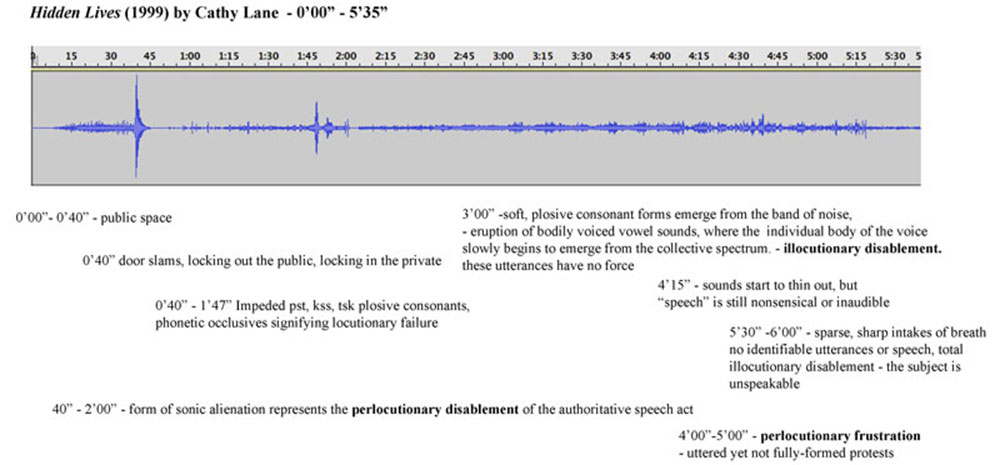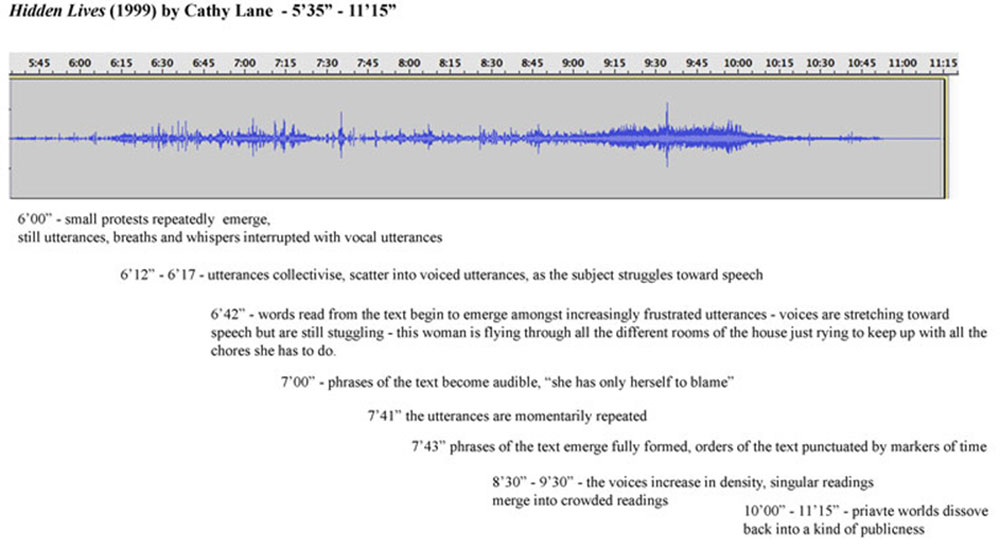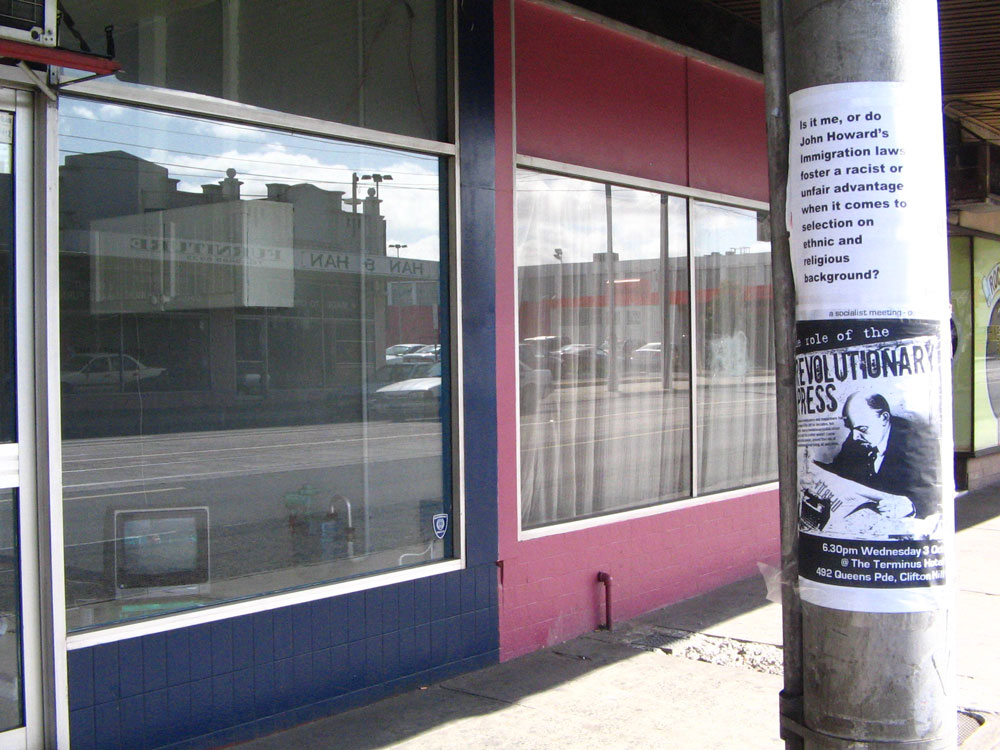Cathy Lane’s Hidden Lives (1999) sounds out a protest about the specifically gendered performances – or speech acts – that The Book of Hints and Wrinkles demands of its readers. But it is a paradoxical protest that moves through the different textual performances of speech act theory, from silence and illegibility to bounded frustration to intelligible speech. The first speech act of note within this composition is the speech act that silences. This is the speech act of The Book of Hints and Wrinkles, which, authoritatively upheld by the norms and conventions of its own time and place – 1930s England – renders any contestation from its intended audience illegible – any protest goes unheard – as a metaphor for the general silencing of ‘women’. Yet, if Hidden Lives posits the claim that the speech acts of The Book of Hints and Wrinkles, by relegating women to the private sphere and an interior space, silences their speech and is a subordinating and authoritative speech act that through its locution ranks, legitimates and deprives, how then can the composition be heard to challenge this speech act that seeks to relegate its protest as nonsene? For the composer, it would appear to be by assuming a position of authority based upon a shared experience as women by which the tropes of language are used against themselves; where the book may speak (presented as the primary speech act), but where the intended action of the speech is frustrated, denied and disabled through a strategic assuming of subordination. This assumption of subordination is a particular performance that intends to challenge the assumed authority of a text that intends to subordinate its reader.
The opening moments of Hidden Lives are filled with footsteps and voices walking along a public thoroughfare. The listener begins in a collective, public space but is quickly and violently locked away by the sound of a reverberant door slamming closed, one that literally silences the soundscape (at 0’40”). Before the door slams there is the bubble of speech and legible communication, after the door slams speech has been silenced. Impeded pst, kss, tsk plosive consonants, phonetic occlusives – in which the vocal tract is blocked – erupt scattered in the soundfield, juxtaposed against a background of low, time-stretched and filtered sound. These low frequencies gradually increase in intensity and occasionally burst as if stretching toward speech, but fail to materialise into any intelligible linguistic form. What this highlights is the demarcation of public and private space with the category of ‘women’ in this composition, whose lives have been hidden from public view and from themselves. The relegation of each speaker to the private realm “deprives the speakers of their language and expression” as reflected in the “heavy editing” of their speech (Lane 2006: 8).
Between 0’40”, from the point that the first door slams in Hidden Lives, to 2’00” when a key in a lock turns, the public communication of the opening seconds of the composition is silenced whereby the speaker is condemned to solitary confinement, both literally in the private realm of the house, but also metaphorically within the ‘interior’ of each isolated individual. This form of sonic alienation represents the perlocutionary frustration and illocutionary disablement of the authoritative speech act.

Katharine Norman writing about Hidden Lives in Sounding Art: Eight Literary Excursions Through Electronic Music (2004) hints toward the performativity of the composition, but keeps her analysis within the realms of the “reading voice”, the “listening voice” and the “authorial voice” as they relate to listening (Norman 2004: 112). It would seem that these ‘voices’ link to locutionary, illocutionary, and perlocutionary acts through notions of authority, intention and legitimacy, but I want to prod that link a little by questioning the notion of experience that the composition sets up.
Paradoxically, Lane’s composition of herself and her friends’ readings of the list from The Book of Hints and Wrinkles, which incidentally was written by anon, queries the foundations of experience by turning the authoritative illocution of the text that has silenced women around on itself through a particular, subversive performance. Yet, I suggest, it should not be taken for granted that the subject of this composition is ‘woman’, but rather the dominant discursive practices that construct the category of the white English woman through hegemonic categorisations of order, obedience, cleanliness and purity that provides the key to the subject of this work. I am not for a moment suggesting that ‘white women’ have an innate purchase on cleanliness or purity but rather that race, ethnicity and nationality – similarly to sex, sexuality and gender – are sociocultural and political constructs as much as they are lived experiences and that these ‘characteristics’ are some of the ways that these categories have historically been constructed.
At about two minutes into the piece, a key turns in a lock. This registers quite a drastic change of space as the listener enters another room in the house of Hidden Lives. The long time-stretched sounds have passed and now the listener is surrounded by sharp intakes of breath and aired initiations, catchings at the throat in efforts to sound, a static, stuttering spectrum of whispered breaths that collectively builds as a mass of insistent, reverberating noise, filling the audio bandwidth. But as yet there is still no intelligible speech. Three minutes in, soft but plosive consonant forms emerge from the band of noise, accentuated by a gradual eruption of bodily voiced vowel sounds, where the individual body of the voice slowly begins to emerge from the collective spectrum. But the noise persists, as a searching for language, for expression, increases and then quickly thins to more sparse and individual stutters, sibilants, trills and fragments. This ‘interior’ world continues, and I want to pause in this space here a moment, where the “community of tiny speech sounds cannot speak because it is truly incorporeal” as Norman suggests, signals the moment of assuming a body, voiced through an “indignity beyond words” (Norman 2004: 111, 113 emphasis in original).
Norman concedes that the sounds as they slowly come to speech are “all women’s voices – this is very clear from the timbre” (Norman 2004: 111). This would quite clearly seem to assume an identity and subject for the work, where it would appear to be about women because of the sound and timbre of the voice. Lane explains in the program notes that the samples are of recordings of her and her women friends reading the text and that it “explores ideas of women as the curators of memory and of hidden histories”, so the knowledge that the composition is by, for and about ‘women’ is already established (Lane quoted in Norman 2004: 110). And its true, it sounds like women´s voices. But, might the timbre1 of the voice not necessarily nor essentially denote ‘woman’ here? Instead might it not be the performative force of the speech act that constructs the voice as gendered, by which we perceive the timbre to be feminine and which relatedly, within a heterosexual matrix, denotes the body within the work as female? It is through the very norms and conventions that are the subject of this composition, that gendered speech has been constructed and by which ¨women’s¨ speech has historically been prevented “from counting as an action”, as being essentially passive (Langton 1993: 299 emphasis in original). This is what signals the gender of the voice in the composition, the fact that the voices have been silenced by the text/composer – by language and authority – not their timbre. The paradoxical construction of the category of women through these discursive silencing speech acts, that essentialised links between timbre and voice confuse, is the crux of the matter, where “the possibility of politics” does not “rest on” nor “follow from, a pre-existing women’s experience” (Scott 1991: 787) but is the means by which experience and sociality are constructed.
In this way it may be perceived that the composer has assumed a subordinate position, initially by silencing the voices in the work, of which hers is one. But why would she do this? If there is a claim within this composition that women’s speech is already denied, frustrated and disabled in a way that hides their ‘true’ lives, why would the composer appear to be complicit in that silencing? I suggest that it is so that she may paradoxically assume and thus undermine a position of authority, associated notions of truth, to challenge the text, whilst also historicising the concept of experience.
Assuming a subordinate position to challenge authority is the paradox in this composition, it is knowingly ironic. For if the claim is that women as a category have been silenced through authoritative illocutionary acts- performative asymmetrical power structures – then it would seem logical to assume that women as a category do not have the required authority within this context to challenge the illocutionary act – the text of The Book of Hints and Wrinkles. Their silence indeed signals a failure to act, or rather a failure of individual action, but perhaps not necessarily a failure of action on the part of the collective memorialising and mimicking of times supposedly past that occurs through the performance of the composition. For the very “structure of impersonation reveals one of the key fabricating mechanisms through which the social construction of gender takes place” (Butler 1990: 136-7). One woman speaking up against the ways that she has been silenced is not perceived as intelligible speech, she is ignored, no matter what she says, she is not heard. To make herself heard within this structure, she needs to be recognised as ‘woman’, where women have historically and been positioned as dialectically necessary and subordinate to men. For this is the only context in which her speech is deemed to have any legible, legitimate authority, in the context of white middle-class cis-hetero-patriarchal supremacy. And this is a performance. By assuming the dominant norms of gender and their supposed internalisation the composition “fully subverts the distinction between inner and outer psychic space and effectively mocks both the expressive model of gender and the notion of a true gender identity” (Butler 1990: 137). Here, “appearance is an illusion”, an auditory illusion (ibid). It is a subversive imitation of silence and noise that effectively displaces the meaning of the original silence as a corporeal re-enactment “that constitutes its interior signification on its surface” (Butler 1990: 139). This is the performative act that Judith Butler writes of in 1990 in Gender Trouble: Feminism and the Subversion of Identity. In response to Norman’s “community of tiny speech sounds [that] cannot speak because it is truly incorporeal” and is “the speechless voice of a disturbed ‘interiority’” (Norman 2004: 111), Butler posits “a corporeal style, an “act,” as it were” (Butler 1990: 139), which is both intentional and subversively performative. Here “performative” suggests a dramatic and contingent construction of meaning” where any notion of an original interiority is played out across the surface of this collective body as the interiority of the composition dissolves into the public realm.

